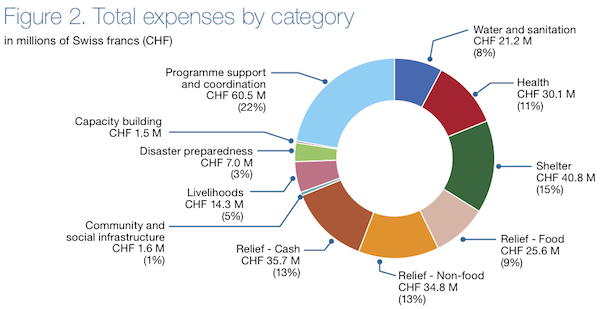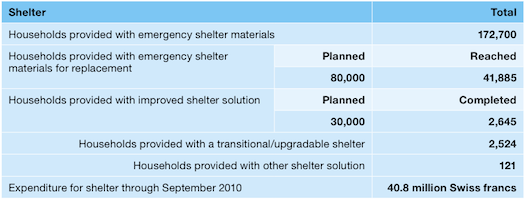Table of Contents
Where we looked
All of the below was examined in October 2010.
- International Federation of the Red Cross and Red Crescent (IFRC) website:
- Where we work: Haiti appeals, updates and reports
- Where we work: evaluations
- Publications:annual reports, financial reports
- Where we work: news stories
- Chronicle of Philanthropy
- The International Federation of the Red Cross and Red Crescent (IFRC) works with and coordinates the efforts of Participating National Red Cross Societies on international disaster relief. For example, after the tsunami in 2005, the American Red Cross as well as nearly 100 other National societies contributed their efforts in the region.1
- IFRC and the American Red Cross (as well as the other National Red Cross Societies involved) post their reports, field updates, and fact sheets on their own websites. Because their operations are distinct, their activities are reported separately in what follows.
How much did the organization raise and how much did it spend?
| Source | Entity | Dates: January 12, 2010 to | Amount donated (Swiss francs) | Amount spent (Swiss francs) |
|---|---|---|---|---|
| Operations Update 22 | IRFC emergency appeal | January 22, 2010 | 37 million CHF | N/A |
| Operations Update 73 | IRFC emergency appeal | February 25, 2010 | 98 million CHF | N/A |
| Operations Update 104 | IRFC emergency appeal | March 24, 2010 | 120 million CHF | N/A |
| 3-month Progress Report5 | IRFC emergency appeal | April 23, 2010 | 138 million CHF | N/A |
| 6-month Progress Report 6 | IRFC emergency appeal | August 6, 2010 | 214 million CHF | N/A |
| 9-month Plan of Action 7 | IRFC emergency appeal | September 24, 2010 | 229.5 million CHF | N/A |
| 1-year report8 | 26 National Red Cross Societies and IFRC's secretariat | September 30, 2010 | 1,118.5 million CHF | 273.1 million CHF |
How specific is the organization about how it spent its funds?
The IRFC provides data on how its expenditures breakdown among 11 categories.9

It also provides examples of outputs for some areas (also provided in the one-year report for the areas of health, water and sanitation, disaster preparedness, livelihoods, and community and social infrastructure):10


Non-disaster relief activities
- The Federation reports its annual expenditures in its annual report, using a standard accounting breakdown (employee benefits, relief supplies, transportation, equipment, travel, communications, workshops and training, information, legal, professional and consultancy fees, administration, office and general, etc.)11 We have not found other breakdowns of its expenses, such as by region or program.
- In its annual reports, IFRC summarizes the year “at a glance” by listing some of its major activities each month.12
- Neither the annual reports nor other sources give a comprehensive account of IFRC's activities (except at the broadest level) or a sense for how IFRC's funding breaks down by program/region.
Sources
- American Red Cross. Tsunami recovery program: Three-year report (PDF).
- Chronicle of Philanthropy. $1.1-Billion Donated for Haiti Relief: Updated Tally. http://philanthropy.com/article/11-Billion-Donated-for-Haiti/65479/ (accessed September 20, 2010). Archived by WebCite® at http://www.webcitation.org/5ssx7IcOw
- Chronicle of Philanthropy. American Charities Raise $774-Million for Haiti Relief, Chronicle Tally Finds. http://philanthropy.com/article/American-Charities-Raise/64243/?otd=Y2x… (accessed September 17, 2010). Archived by WebCite® at http://www.webcitation.org/5t63TTO4P.
- Chronicle of Philanthropy. American Charities Raise $709-Million for Haiti Relief, Chronicle Tally Finds. http://philanthropy.com/article/American-Charities-Raise/64193/ (accessed September 17, 2010). Archived by WebCite® at http://www.webcitation.org/5solB4OOD.
- Chronicle of Philanthropy. Haiti Donations Exceed $644-Million. as of February 3. http://philanthropy.com/article/Haiti-Donations-Exceed-644/63887/ (accessed October 3, 2010). Archived by WebCite® at http://www.webcitation.org/5tD60TduA.
- Chronicle of Philanthropy. Tsunami Donations: Money Raised and Spent (Dec 8. 2005). http://philanthropy.com/article/Tsunami-Donations-Money/58739/ (accessed September 17, 2010). Archived by WebCite® at http://www.webcitation.org/5tD4WBWkz
- IFRC. Annual report (2008).
- IFRC. Haiti: 3-Month Report.
- IFRC. Haiti: 6-Month Report.
- IFRC. Haiti: 9-Month Plan of Action.
- IFRC. Haiti: Operations Update 2.
- IFRC. Haiti: Operations Update 7.
- IFRC. Haiti: Operations Update 8.
- IFRC. Haiti: Operations Update 10 (PDF).
- IFRC. Haiti: Operations Update 16.
- IFRC. Haiti earthquake 2010: One-year progress report (PDF).
- IFRC. News: Press releases. http://www.ifrc.org/news/press.asp?navid=06_02 (accessed January 10, 2010). Archived by WebCite® at http://www.webcitation.org/5vdtXn3hf.
- IFRC. Publications: Annual report. http://www.ifrc.org/publicat/ar/index.asp?navid=09_05 (accessed January 10, 2011). Archived by WebCite® at http://www.webcitation.org/5vdtSMQvC.
- IFRC. Tsunami real time evaluation synthesis report (PDF).
- IFRC. Real Time Evaluation (first round) - Recommendations and Responses (PDF).
- IRFC. Where we work: Haiti (2010). http://www.ifrc.org/where/country/cn6.asp?iYear=1&xFlag=2&countryid=80&… (accessed January 5, 2011). Archived by WebCite® at http://www.webcitation.org/5vWEINzdc.
- IFRC. Where We Work: Monitoring and Evaluations. http://www.ifrc.org/where/evaluation/index.asp (accessed November 27, 2010). Archived by WebCite® at http://www.webcitation.org/5uYMjTsHp.
- IFRC. Who We Are. http://www.ifrc.org/who/movement.asp (accessed October 2, 2010). Archived by WebCite® at http://www.webcitation.org/5tBJTSBio.
- 1
“Nearly 100 members of the International Federation of the Red Cross and Red Crescent Societies (International Federation) around the world have provided assistance in tsunami-affected countries. The American Red Cross coordinates and forms operational alliances with these Participating National Societies (PNSs) based on the technical expertise, established geographic presence and operational capacity of each.” American Red Cross, "Tsunami recovery program: Three-year report," Pg 5.
- 2 IFRC, “Operations Update 2,” Pg 1. The report gives the percentage of the appeal amount raised; the donated amount was calculated by multiplying the appeal amount by the percentage raised.
- 3IFRC, “Operations Update 7,” Pg 1. The report gives the percentage of the appeal amount raised; the donated amount was calculated by multiplying the appeal amount by the percentage raised.
- 4IFRC, “Operations Update 16,” Pg 1. The report gives the percentage of the appeal amount raised; the donated amount was calculated by multiplying the appeal amount by the percentage raised.
- 5IFRC, “3-month report,” Pg 1. The report gives the percentage of the appeal amount raised; the donated amount was calculated by multiplying the appeal amount by the percentage raised.
- 6IFRC, “6-month report,” Pg 1. The report gives the percentage of the appeal amount raised; the donated amount was calculated by multiplying the appeal amount by the percentage raised.
- 7IFRC, “9-month plan of action,” Pg 11.
- 8
"Total Red Cross Red Crescent income through September 2010: 1,118.5 million Swiss francs. Total Red Cross Red Crescent expenditure through September 2010: 273.1 million Swiss francs." IFRC, "Haiti Earthquake 2010: One-Year Progress Report," Pg 5. "The financial information in this report combines unaudited data from 26 independent National Societies (listed below) and the IFRC's secretariat, which is conducting Haiti relief and recovery operations on behalf of 95 National Societies which contributed directly to its Haiti appeal." IFRC, "Haiti Earthquake 2010: One-Year Progress Report," Pg 32.
- 9
IFRC, "Haiti Earthquake 2010: One-Year Progress Report."
- 10
IFRC, "Haiti Earthquake 2010: One-Year Progress Report." Notes on how IFRC defines the reported outputs and how the data was collected are given on Pgs 37-47.
- 11
IFRC, "Annual Report (2008)," Pg 22.
- 12
For example, in June 2008:
"The Sudanese Red Crescent Society faced an acute watery diarrhoea epidemic affecting the country. Supported by the IFRC, the National Society assisted 360,000 people. The World Disasters Report 2008 focused on the challenge of HIV in disasters and crises. The report recommends that all humanitarian programmes should integrate the complexity and longterm nature of HIV and AIDS in order to effectively tackle the epidemic. Typhoon Fengshan struck the Philippines destroying over 75,000 houses, seriously damaging a further 200,000 and affecting at least 2.5 million people across the country. The Philippine National Red Cross assisted 6,000 families over 12 months.” IFRC, “Annual Report (2008),” Pg 6.
